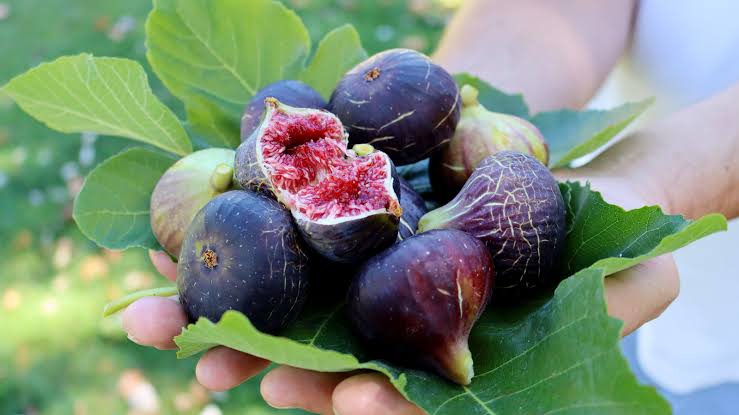Figs(anjeer) - Ayurvedic remedies, Health benefits, application, chemical constituents, side effects and many more
Common Fig (anjeer)
Fig which commenly called as anjeer. It is delicious sweet fruit with multiple seed. Fresh and dried Anjeer (Anjir) are widely consumed in Mediterranean countries and it is popularly known as ‘the poor man’s food’. Anjeer dry fruit and its other parts such as bark, leaves, shoots, latex, and seeds are medically important,It is eaten in their dried and wet format. Anjeer are are good source of with vitamins and minerals as well as di.................................read more
• Vitamins : K, B1, B2, B3, B5, B6, B9, A, C, E
• Minerals : Calcium, Manganese, Potassium, Magnesium, iron, zinc, phosphorus, sodium, copper
• Fruits consist 62% sugar in the dried form and 22% sugar in the fresh form.
• The fresh and dried figs also contain high amount of fiber and polyphenols(proanthocyanidins).
The fresh and dried figs also contain high amounts of fiber and polyphenols. Figs are an excellent source of phenolic compounds, such as proanthocyanidins, whereas red wine and tea, which are two good sources of phenolic compounds, contain phenols lower than those in figs.
•Various volatile constituents of five Portuguese varieties of F. carica fruits (pulps and peels) have been isolated which include aldehydes: 3-methyl-butanal, 2-methyl-butanal, (E)-2-pentanal, hexanal, heptanal, octanal, and nonanal, alcohols: 1-penten-3-ol, 3-methylbutanol, benzyl alcohol, (E)-2-nonenol, and phenylethyl alcohol, ketone: 6-methyl-5-hepten-2-one, esters: methyl hexanoate, methyl salicylate, and ethyl salicylate, monoterpenes: lim.................................read more
Why to soak Figs?
Dried figs are hard to digest, so it is better to soak them first. For soaking, figs should be washed first. These should be soaked in drinking water. Then remove anjeer on early morning and drink the anjeer soaked water and eat anjeer.
Figs are extremely sweet and astringent fruit which is hard to digest and has coo.................................read more
Parts of plant used
Fruit, bark, leaves, shoots, latex, and seeds
1) The fruit's juice of Ficus mixed with honey is used for haemorrhage.
2) Certain compounds in leaves and roots of fig have been identified effective against different disorders such as gastrointestinal (colic, indigestion, loss of appetite, and diarrhea), respiratory (sore throats, cough, and bronchial problems), inflammatory, and cardiovascular disorders.
3) Figs are good for eye sight and can be used as aid in liver
4) Figs are used as an excellent source of minerals, vitamins, carbohydrates, and dietary fibre because it is fat and cholesterol free and contain high number of amino acids
It is also reported that figs have been conventionally used for their therapeutic benefits as laxative, cardiovascular, respiratory, antispasmodic, and anti-inflammatory remedies
5) In Indian medicine, fruits are used as a mild laxative, expectorant, and diuretic. It is used as aid in liver and spleen diseases.
Fruit paste is applied to swellings, tumours, and inflammation for relieving pain.
Fig(Anjeer) can heal various respiratory problems like asthma and whooping cough.
Regular intake of Fig(Anjeer) will give good vision in older people.
6) To prevent stomach ache and indigestion, take 3 grams of Fig(Anjeer) fruits with 5 grams of Fig(Anjeer) fiber and consume it.
7) Applying Anjeer paste along with honey on the face can help improve skin health.
8) To gain the weight, take 2 to 3 Fig(Anjeer) & dried Khajoor soak them in milk at nig.................................read more
Note:
- Excessive clacium loss in urin is due to high concentration of sodium.when we give require amount of potassium it some time helps to reduce the losses of calcium through urine. So anjeer is helpful to treat these condition also.
- It works against harmful effect of sodium.
- It is believed that fig is useful to give strength & moisturization to the hair because of its vitamin, minerals & antioxidant content.
- Eating anjeer regularly is the be.................................read more
If you want to give more suggestion in this, then comment us, we will replay your comment.
If you like this post, then share it and follow us on Instagram (@healthyeats793) and many thanks for coming to our site Healthy eats
keep visiting
Support us
3) Facebook
4) Pinterest
🙏🙏Subscribe and share for latest updates 🙏🙏
More posts from our site
- Click here for more information about Tamarind
- Click here for more information about Nutmeg (Jaiphal)
- Click here for more information about Viruddha aahra
- Click here for more information about Jambul (java phalam)
- Click here for more information about Marking nut (bibba)
- Click here for more Home remedies of Nirgundi
- Click here for more information about saffron
- Click here for more information about Elephant foot/Yam
- Click here for more information about Watermelon 🍉🍉
- Click here for more information about Jackfruit/phanus
- Click here for more information about summer care 🌞
Refrance :
- NCBI
- Hindwai.com
- IOSR Journal of Biotechnology and Biochemistry
- PUBMED
- CENTRAL COUNCIL FOR RESEARCH IN UNANI MEDICINE
- Ministry of AYUSH, Government of India
- International Journal of Research in Pharmacy and Pharmaceutical sciences
- Evid Based Complement Alternat Med. 2013; 2013: 974256. PMCID: PMC3789402
- Ann Nutr Metab. 2011 Aug; 58(3): 232–238. PMCID: PMC3169356
- Lab Anim Res. 2011 Dec; 27(4): 275–281. PMCID: PMC3251757
- Charaka Samhita
- Sushruta Samhita
- International Journal of Pharmaceutical and Phytopharmacological Research.2012, 1(4): 215-232, ISSN (Online) 2249 – 6084
- Asian Journal of Biomedical and Pharmaceutical Sciences, Volume 3, Issue 18, 2013, 22-28.
- Journal of Current Research in Food Science 2021; 2(1): 07-11
- Local Tradition and Knowledge







Comments
Post a Comment